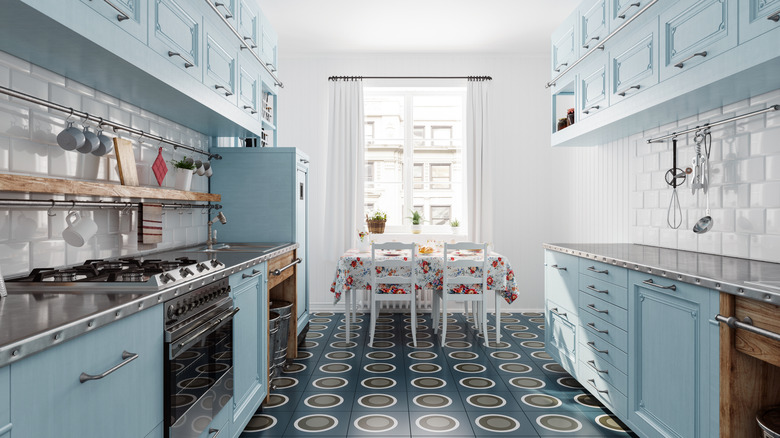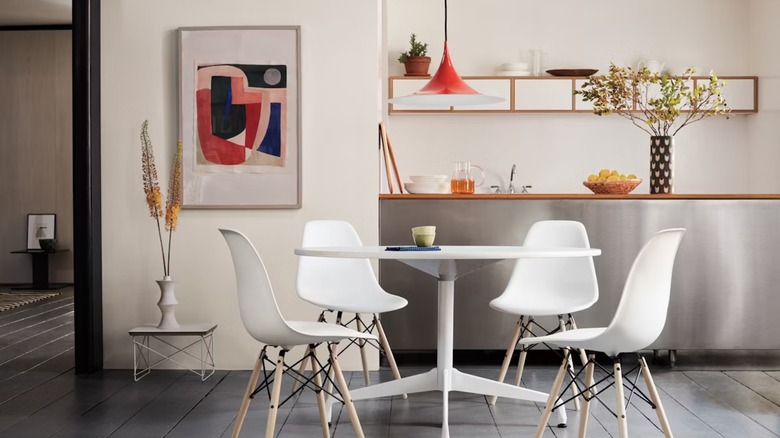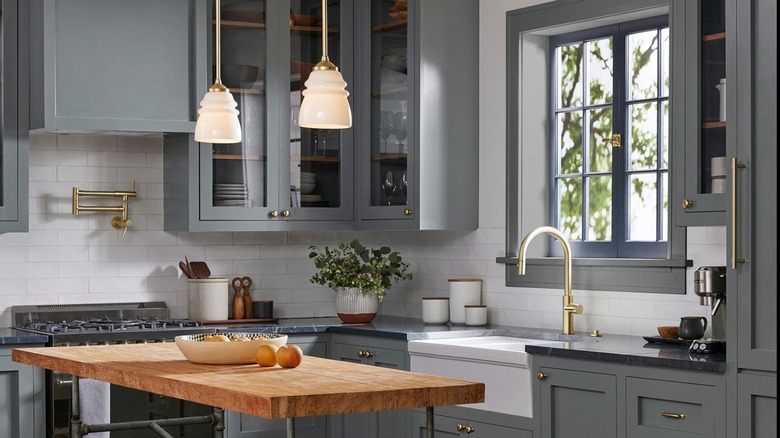12 Vintage Kitchen Trends That We'd Love To See Being Used Today
We may receive a commission on purchases made from links.
Old kitchen trends have a way of coming back around, oftentimes reimagined with a contemporary twist. There's an undeniable charm about vintage kitchens that makes them a nostalgic inspiration source. With some homeowners and designers looking to shift away from sparse, ultra-minimalist homes, it's a good time to revisit vintage kitchen trends that are full of character and charm. We've rounded up some up-and-coming vintage kitchen trends we'd love to see used in today's kitchens.
The ideas ahead span the gamut from easy tips and tricks to give your overly-modern kitchen more vintage charm to full-on renovation ideas. A few ideas can be renter-friendly, while others are inspiration for a complete kitchen transformation. Borrowed from the kitchens of yesteryear, these vintage trends are ready for a comeback.
Warm wood cabinetry
With a trend toward traditional touches, there's also a shift to preferring real materials and classic craftsmanship. Warm-toned, real wood cabinetry embodies this. Oak, maple, and other wood cabinets were trending only decades ago throughout the '80s and '90s. These cabinets often had an orange or honey-colored hue and have been frequently labeled as dated — all over social media, you'll see people updating these types of kitchens. But with a return to more traditional styles, tides are turning, and this "dated" feature can feel warm and nostalgic again. Their organic texture and color feels more natural and cozy than shiny mass-produced materials.
If you still have a '90s kitchen chock full of wood cabinets (and many homes do), instead of looking to renovate, lean into the era's charm. If you really need a refresh, consider staining them a new (but still natural-looking) color and updating the hardware. Antique-inspired hardware is one vintage kitchen trend making a comeback and it looks beautiful on wood doors. If you're in the market for a renovation, consider solid wood cabinets. It doesn't have the futuristic or sleek feel of some synthetic materials, but it's endured for a reason. It's durable and easy to refinish, so if you get sick of a color, you can always update it one day.
'70s-inspired color palettes
Earthy colors were on-trend in the '70s kitchen, and they deserve a revival. Popular shades included avocado green, warm gold, burnt orange, mustard yellow, walnut brown, olive green, and burgundy. Inspired by nature, these shades make a kitchen feel homey and grounded. These '70s-inspired colors follow along the lines of a few contemporary trends, so they will likely continue to grow in popularity going forward. The colors are bold, but not jarringly bright — a welcome alternative to the all-gray trend that's being left behind in 2025. They have a warm undertone, and warm interiors are trending for their coziness. Plus, with biophilic styles and natural elements on the rise, these nature-inspired colors are a muted, but colorful, choice.
Though these colors might sound intense after years of neutral kitchens, they're not too stark in practice — you can choose to tone the idea up or down. A toned down version might be a contemporary kitchen, but with vintage-inspired avocado green and warm gold accents in the form of a backsplash and some decor. A bolder choice would be to go all-out with one of these colors, like painting all your cabinets a mustard yellow. To lean even more into the '70s inspiration and for ultimate visual interest, you can include bold '70s patterns in the form of flooring or wallpaper. If it's one of your favorite eras, modeling a kitchen after this bright and playful decade is one way to style a funky retro kitchen.
All-out kitsch
There's no need to hide your knick knacks in the name of minimalism. Displaying all the collected items you love is one way to approach maximalism successfully, since it's about showing personality through decor. And really, kitsch is a natural place for maximalism to go (or rather, return to). Kitschy kitchen style will particularly suit those who want to incorporate the items they love, with a focus on vintage touches. Full-on kitschy kitchens were popular in the '70s, but does collecting things you love ever really go out of style? As minimalism fades from center stage, expect kitchens to also lean more eclectic, with the focus on personal style. If you love vintage and cutesy, your style can easily enter into kitsch territory.
To put this in practice, instead of trying to make your kitchen look perfectly neat, lean into the joy of displaying all your favorite finds, even if it means a little more clutter. On counters or shelves, place interesting glassware, colorful mugs, pastel mixing bowls, decorated plates, retro appliances, and a statement cookie jar (it's a mainstay of the kitsch kitchen). An option like the Peter Rabbit Cookie Jar is charming and nostalgic. There are several vintage kitchen accessories making a comeback that are perfect for kitsch kitchens. Some noteworthy examples include bread boxes, quirky canisters, antique scales, and playful salt and pepper shakers. There are lots of creative product options for the latter, one example is the Pacific Trading Tea Cup Pups Salt and Pepper Shaker Set, which is shaped like two dogs in tea cups kissing. You can truly find the most fun and out-there ideas to float any boat.
Art nouveau details
The art nouveau style has an otherworldly feel to it that makes it incredibly endearing for those who love whimsical decor. This style was popular in the late 19th and early 20th century. Its main traits include curved details, flowy and sinuous organic lines, asymmetry, and nature-inspired motifs like vines, leaves, flowers, and insects. There's a lack of straight lines in this design movement, with nearly every surface rounded in shape or adorned with some type of curved accents. Comparing it to a modern design trend, it has some similarities to cottagecore, but more grown-up and refined. In fact, it's a good next step to elevate a cottagecore kitchen if you want something more elegant and enchanting, as well as cozy.
It's not very easy to find art nouveau kitchen appliances or furniture. In part, it's because this style isn't as popular (its successor Art Deco is more likely to steal the spotlight). Art nouveau interior design features also don't really lend well to mass production, which is part of its charm. You can DIY art nouveau details, though. For example, in this video from @wanderingpeacockhouse, they make a stunning custom door frame. A smaller project is this custom art nouveau mirror from @anaiscassiers that you can hang up somewhere in your kitchen. Or you can buy some decor in this style: The Vakker Lotus Leaf Glass Chandelier is an excellent example of art nouveau lighting. Perhaps one of the easiest upgrades inspired by this movement is to replace your cabinet knobs with these Altered Tile Design Handcrafted Mucha Decorative Round Wood Knobs, inspired by Alphonse Mucha, one of the prominent artists of this time.
Beautiful stained glass
Stained glass has been around for a long, long time. It was popular between the 12th and 16th century in European cathedrals and churches. More recently, it made its way into homes during the late 19th and early 20th century, particularly in Victorian, Craftsman-style, and art nouveau homes, and now, in homes that draw inspiration from those movements. It's existed for so long that it's truly timeless, now with some contemporary designs available too, as well as intricate antique styles.
Stained glass accents always bring character to a kitchen. You can incorporate stained glass in windows, doors, cabinet doors, lamps, hanging decorations, and even as a ceiling panel (an example of the latter is shown in this project from @wanderingpeacockhouse). Today, you can also buy window films to mimic it yourself, like the Artscape Magnolia Window Film. Or, buy panels that you can hang in front of a window — another great solution to get the look without having to replace any panes. The Aspen Tiffany Stained Glass Transom Window Panel is a charming pick for this purpose. If you want true vintage character, there are local artisans keeping the trade alive, so you can get the real thing. Handcrafted stained glass windows are expensive, but worthwhile if you value authenticity. You can also find real stained glass accessories, like this Tiffany Honey Locust Table Lamp, which might be more in-budget if you want real craftsmanship that doesn't cost thousands of dollars.
Appliances with character
Quite frankly, new appliances all look the same, and for some, it's getting really boring. Most new appliances, large and small, are minimalist and boxy with a sleek metal finish. That's great for modern spaces, but it can interrupt the flow of a vintage-inspired kitchen. Vintage-looking appliances have much more personality and are a good alternative if you're tired of modern fare.
Most common kitchen appliances come in vintage-inspired styles, including microwaves, coffee makers, refrigerators, and ovens. Some homeowners go for the real thing, and if you're willing to source them, there are some vintage kitchen appliances you should have for your kitchen that come chock-full of cool old-school features. Otherwise, you can shop modern options (many with modern conveniences) that just look vintage. Colorful retro products are plentiful, the Nostalgia Retro Countertop Microwave Oven and Big Chill Retro Original Fridge being two examples. These hark back to '50s kitchen style. If you're not after that retro pastel look though, you can also find more antique-style pieces like the icebox-style Big Chill Classic Fridge or Kucht 4-Burners Dual Fuel Range.
Playful mid-century modern touches
Mid-century modern style came about in the mid-20th century and has been pretty prominent ever since, waxing and waning in popularity with a recent 21st century resurgence. You can find all sorts of mid-century modern inspired furniture from retailers like Target, IKEA, and West Elm, but these designs take on a more contemporary, minimalist version of the style. If you're ready to introduce more true vintage touches, instead, lean toward the funky side and focus more on the "mid-century" aspect. There are a lot of mod mid-century pieces that are playful that can bring more joy to a kitchen. Examples include sunburst clocks, tulip tables and chairs, funky lamps, and geometric pendant lighting. Instead of contemporary neutrals, you can also choose bolder colors that were popular in this post-war era.
The height of mid-century modern style wasn't all too long ago, so you might be able to find real vintage pieces at thrift stores or estate sales. Even shopping new, there's plenty of funky stuff to be found, like the Herman Miller Nelson Sunburst Clock and SchoolHouse Flip Clock. Tulip chairs and tables come in modern iterations, but the warm wood of the Hernest Berit 60" Dining Table brings some traditional coziness. It's also fairly easy to find eccentric mid-century modern lamps and lights, like the SchoolHouse Teig Lamp, as one example.
Glamorous Art Deco tiling
If you want to inject vintage glam into your kitchen, installing Art Deco tiling is one way to do so. Art Deco was popular in the '20s and '30s, shaped by the decadence of these hopeful decades. The style is luxurious and opulent, with geometric and streamlined designs, striking jewel tone colors, symmetry, and lavish materials. There are a few ways to make your kitchen look Art Deco, but if you're renovating and after a big statement, one excellent way is with Art Deco tiling. Whether as a backsplash or as floor tiling, it will transform the look of the room.
Art Deco tiles are available in all sorts of designs, many intricate and symmetrical. You can find colorful options, too, that lean into the luxe look. Choose colors that signal opulence, including jewel tones, deep shades like ruby red, royal blue, royal purple, and metallic elements. Some excellent tile examples include the Merola Tile Art Deco Daiquiri Porcelain Patterned Wall & Floor Tile and TileBar Nabi Fishscale Crackled Glossy Glass Mosaic Tile. An option with a classy metallic accent is the The Tile Shop Moderne Deco Stone Mosaic Tile. Even if you're renting, you can cop the look with peel-and-stick products like the Funlife Art Deco Peel and Stick Kitchen Backsplash.
Checkerboard flooring
Checkerboard floors pop up several times across history in very different iterations, from checkered stone tiles in ancient civilizations to vinyl black-and-white tiles in old-school diners. It's a classic pattern that can be interpreted many different ways, so you can draw inspiration from any era. In this video from @mr.harry.white, they show "outdated" vinyl black-and-white checkerboard flooring, which has been making a retro comeback lately. For an upscale feel, consider marble tile flooring in a diamond pattern. This video from @gabsburbary shows this European-inspired design. Remember, you can choose various colors or sizes for your squares. A distinctive choice is in this video from @sarahlongroper, where they have beautiful stained wood checkerboard flooring.
If you want to install real checkerboard flooring in the kitchen, that's a pretty big renovation. But it's also the most long-wearing and nicest looking choice. Otherwise, there are plenty of peel-and-stick products for those who want a more temporary solution — these come in far more colors than just black and white nowadays, too. Lastly, the easiest way to get some of the look is with a checkered kitchen runner. It's not quite as striking as full floor tiling, but the Lahome Checkered Easy Jute Runner Rug can help you add this timeless historical pattern to any kitchen.
Terrazzo surfaces
Terrazzo is another item on this list that dates back to ancient times. The National Terrazzo and Mosaic Association traces first signs of terrazzo-like materials to the Neolithic period in the Middle East. Like checkerboard floors or stained glass, it's come in and out of use in different times and regions around the world. More relevant to modern times, terrazzo had an American resurgence in the 20th century. Several of the U.S.'s famous icons have terrazzo flooring (the Empire State Building, Radio City Music Hall, and the Hollywood Walk of Fame, to name a few). Terrazzo enjoyed popularity during the Art Deco and mid-century modern eras, so it's something we can still see today.
Terrazzo didn't often have much of a place in contemporary minimalist kitchens, where sleek and plain surfaces prevailed. But if you're looking for a fun pattern, it's is a playful choice that adds visual texture. There are lots of terrazzo options, with different materials, colors, and sizes of aggregate. It's possible to have terrazzo installed directly to the floor (by embedding aggregate into binder and pouring, curing, and polishing it directly on the floor) or as tiles. In this day and age, of course there's terrazzo-patterned peel-and-stick too. Lowest effort and renter-friendly is terrazzo tables and accessories, perfect for if you just want a low-commitment touch of this pattern. The Modway Zinque 60" Oval Terrazzo Dining Table and Pretti.Cool Terrazzo 5" Catchall are two products that can bring the look to any kitchen.
Vintage light fixtures
Light fixtures are one of those functional features that punch above their weight when it comes to style: More than just a practical item, they can really affect the look of a kitchen. Minimalist light fixtures and bright, flush mount ceiling lights were all the rage in the last decade, but they can feel sterile and boring if you're wanting to craft a vintage-inspired space.
Anything from the mid-century modern Vakkerlight Anna Pendant Lamp to Rejuvenation Vintage Victorian Sconce to the notorious "boob light" counts as vintage-inspired lighting, so you can truly find a wide gamut of products to suit your style. A kitchen lamp is one recent example of this vintage kitchen lighting trend taking off: It adds coziness and people tend to choose antique-inspired lamps (with pretty old-fashioned lampshades). If you generally want a more vintage-inspired look, consider using pendants, chandeliers, and wall sconces, which often have a more old-fashioned feel.
Gothic touches
The Gothic style originated in the Middle Ages and resulted in many impressive churches and cathedrals. Contemporary gothic decor draws some traits from this medieval movement, including dark colors, ornate details, moldings, arches, stained glass, and straight, vertical elements. It's turned into its own style nowadays, but borrows a lot from these centuries past. When it comes to a gothic kitchen, think along the lines of an ornate traditional space, but with a darker element to it. Moody colors have been trending lately, and a Gothic-inspired kitchen takes this to the next level, often employing almost-black shades. These designs can sometimes lean witchy, though that borrows from current interior design ideas, like the whimsigoth decor trend, rather than the past. Whatever direction you choose to take it, Gothic touches can create an atmospheric kitchen.
Gothic-inspired interior paint colors are mysterious and resplendent. You aren't limited to black. You can also choose other dark shades, such as stained glass-inspired colors like deep red, purple, and blue. A larger reno might involve painting cabinets, installing broody wallpaper, like the Copper Garden Wallpaper, and adding intricate wall and ceiling molding. Gothic-inspired touches can come in the form of hardware, like the Saturn Cabinet Knob with Star Backplate. Renter-friendly options include accessories like the ornate black Amaya Runner Rug or the charcoal-colored Mason Stoneware Dinnerware Sets — there are lots of opportunities to bring out your inner goth with vintage accents.


